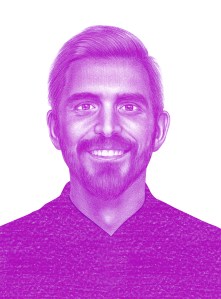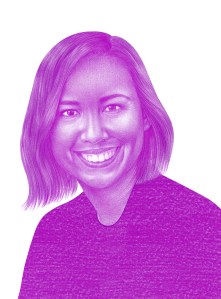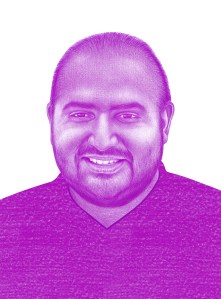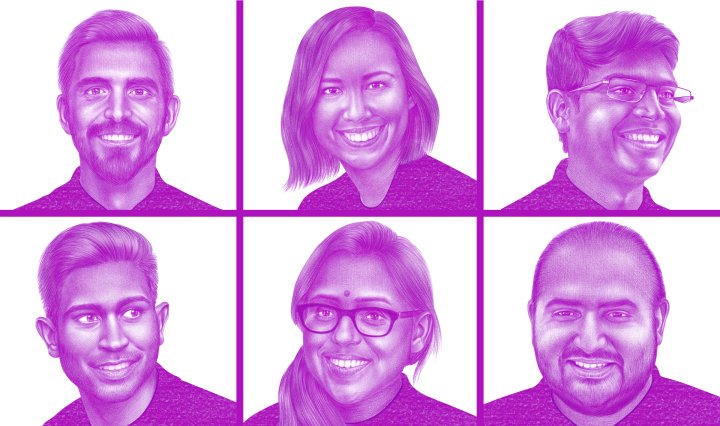The editors of TIME for Kids spoke with six innovators who are making the planet a more sustainable and accessible place for future generations. From Saieshan Govinder’s work tackling the youth unemployment crisis in South Africa to Srilekha Chakraborty’s initiatives that help girls in rural India learn and talk about their health, these game-changers are leading the way to a better world.
Claudiu Leverenz
 Illustration by Aiste Stancikaite for TIME
Illustration by Aiste Stancikaite for TIME For wheelchair users, especially those who are unable to control their chair manually, Claudiu Leverenz’s Munevo DRIVE could be life-changing. It enables users to steer using head movements and smart glasses. The glasses have sensors that translate head movements into control signals, which are then sent to the wheelchair.
Munevo DRIVE has been available on the German market since January 2019. The response has been positive. “Immediately, the product gained so much traction and excitement,” Leverenz, 30, told TIME.
Back in 2015, while studying at the Technical University of Munich, in Germany, Leverenz and a classmate researched ways to enhance mobile independence among wheelchair users. “It became clear that the (wheelchair) industry is very traditional and hasn’t really changed so much,” Leverenz says. “They didn’t incorporate new technology and software into their products.” After graduating, Leverenz sought to turn what was a school project into a tangible solution. In 2018, he launched a startup with a mission to bring innovative technologies to those with disabilities. Munevo DRIVE is its first product.
Leverenz and his team are now working to bring the smart-glass solution to the global market. They hope to make Munevo DRIVE available to the rest of Europe and the U.S. this year. —Rebecca Mordechai
Read more of TIME's Davos 2020 coverage
Neel Tamhane
 Illustration by Aiste Stancikaite for TIME
Illustration by Aiste Stancikaite for TIME Close to a billion people worldwide lack access to clean, affordable energy. That’s why Neel Tamhane, 27, wants to build solar-powered micro-grids in remote areas of the developing world. Tamhane leads the solar project at SPACE 10, an IKEA-backed independent research and design lab in Delhi, India.
Solar energy is not new to some rural areas. Many homes use a small solar panel to power a couple of light bulbs and—maybe—charge a cell phone. “This was okay a decade ago, but its time has passed,” Tamhane says. “Everyone wants to step up in the energy level.”
That step-up is to community-owned solar power. Tamhane aims to build local networks, so villagers can pool their energy, freeing them of inefficient and unreliable utilities. Only a few homes would need a rooftop solar panel. Using a smart device, these homes could sell their surplus solar electricity through the village blockchain, much the way bitcoin is traded. Other homes connected to the grid can buy that electricity, then sell their surplus for credit to spend at any local store. The network can link up with the next village, and so on, creating a self-sustaining renewable-energy economy.
SPACE 10 has exhibited its 1:50-scale prototype around the world, pitching small-scale energy trading as a clean and affordable way of becoming less dependent on fossil fuels. “The future of utilities is going to be decentralized and has to be democratized,” says Tamhane. —Brian S. McGrath
Saieshan Govinder
 Illustration by Aiste Stancikaite for TIME
Illustration by Aiste Stancikaite for TIME A quarter-century after the end of apartheid, political liberation has yet to bring about significant economic gain for many black South Africans. For young people, the situation looks particularly dire; some 6.8 million youth are unemployed.
Saieshan Govinder, 29, is doing his part to redress the history of apartheid. Govinder works for Youth Employment Service (YES), a nonprofit launched in 2018 by President Cyril Ramaphosa to tackle the youth unemployment crisis. At YES’s Johannesburg office, Govinder helps young South Africans find entry-level positions in the digital sector. He organizes courses in resume building, letter writing, and training in digital technology. “Seeing the passion and fire in these young people to find a job is amazing,” he says. “It’s what makes me feel like getting up every morning.”
So far, Govinder has helped YES place some 30,000 young people in jobs.
Govinder’s own resume reads as a testament to the power of education. After working as a tutor and curriculum designer, he founded in 2014 the nonprofit Mathemission with the aim of bringing math and science tutoring to underprivileged children. Last year, he was named an Obama Foundation Africa Leader. Govinder say his parents, who are Indian, could not attend university under apartheid: “I push myself to make them proud of what they didn’t have the opportunity to achieve.” —Brian S. McGrath
Sophia Hamblin Wang
 Illustration by Aiste Stancikaite for TIME
Illustration by Aiste Stancikaite for TIME Australia-based company Mineral Carbonation International (MCi) and its chief operating officer, Sophia Hamblin Wang, 31, want to decarbonize high-polluting industries, such as steel and cement. “If we can create business models,” she says, “we can incentivize these industries quicker than waiting for governments to legislate.”
The company’s business model has taken the form of building materials made from carbon dioxide itself. The CO2 is mixed with minerals to create a solid, which can then be used to make green building materials, such as bricks. In other words? “We take CO2 from any industrial source or sucked out of the atmosphere and we create value out of it,” says Wang. MCi’s pilot phase in Newcastle, New South Wales, began in 2013 and is up and running. Now Wang and team are scoping out their next location.
Many green products have a hard time finding their way, falling victim to the “valley of death” without proper funding or support, Wang says. But if young people demand their employers engage in sustainability practices “above and beyond what the law requires,” it will be easier for innovations like MCi’s to be successful. “When I was in university, I was particularly looking to work for a company that had green or sustainability credentials,” she says. “I wanted to use my career to make the world a better place.” —Allison Singer
Srilekha Chakraborty
 Illustration by Aiste Stancikaite for TIME
Illustration by Aiste Stancikaite for TIME Srilekha Chakraborty, 31, works with women and girls in Jharkhand, a rural state in eastern India. There, it’s easy for women’s issues to get lost among other priorities. “In areas where there’s poverty, where there’s struggle for survival, gender and sexuality becomes secondary,” says Chakraborty. “But we can’t say, ‘let’s work for 20 years on education and food security, and then we will give gender understanding to these communities.’ Everything should be parallel.”
Chakraborty is using theatre and visual arts to help change the public-health conversation in Jharkhand. In May, she led a workshop during which people ages 16-22 discussed public and menstrual health, then planned and painted two murals in busy areas about menstruation. One mural features a girl flying fearlessly in a red sea. The other shows girls plucking fruits from and reading books under a red-flowered gulmohar tree—which the community asks them not to touch while they’re menstruating. “It’s a taboo where they think that the plants will die and stop bearing fruits,” says Chakraborty.
Chakraborty agrees with a common sentiment in today’s girl-powered climate: “Yes, we need to teach our girls to break things, to build things, to destroy and to construct.” But, she says, her aim is to find innovative ways to make sure girls in marginalized communities aren’t left out: “We have to give them the same opportunities.” —Allison Singer
Amornthep Sachamuneewongse
 Illustration by Aiste Stancikaite for TIME
Illustration by Aiste Stancikaite for TIME With the Sati app, Amornthep Sachamuneewongse of Bangkok wants to build an “army of listeners” to assist people in need. The idea was born of personal experience. In 2018, Sachamuneewongse, thinking of ending his life, reached out to a suicide hotline. “No one picked up my call,” he says.
The experience shook him. It also inspired a renewed sense of purpose. “I need to create something of my own to help people,” Sachamuneewongse, 30, recalls thinking at the time.
Currently in development, Sati will be a free “on-demand listening app” designed to support people experiencing a range of issues. “You can just be stressed or feeling sad or need to vent,” Sachamuneewongse says. And unlike with other mental-health apps, “You don’t talk to a psychiatrist or psychologist,” he adds. “You just talk to a person with deep and active listening skills.” In Thailand, where the app will launch, Sati’s network of volunteer listeners will be trained by the country’s Department of Mental Health.
Eventually, Sachamuneewongse hopes to broaden Sati’s reach. “I want this to go across borders,” he says. “Everyone has it in themselves to be a more empathetic listener; everyone has it in themselves to help one another out.” —Jaime Joyce
TIME's Davos 2020 issue was produced in partnership with the World Economic Forum.
Correction, Jan. 20
The original version of this story misstated Leverenz's invention. It is the smart-glass product, not the chair itself.

















